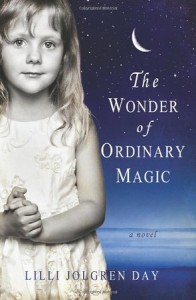
The chapters of The Wonder of Ordinary Magic alternate POVs between the seven major characters who are members of an extended family. Bobby is a successful novelist, currently in a coma. Chloe is his 4-year-old niece. Miranda is his sister-in-law, Chloe’s mother, a psychiatrist. Tom is Bobby’s brother, 7 years older than Bobby, a tax accountant. Michael is Miranda’s brother, a photographer, 38 years old (their mother, Mary, died a year ago), and Jack is their father, 73 years old. Josh is Michael’s boyfriend, both are in the construction field. Bobby’s chapters are written in first person, while everyone else is in third person.
While lying in his coma, Bobby shares his thoughts about his life as he (mentally) continues to work on a novel-in-progress. Excerpts from that story begin about a quarter into the main novel, with a parallel back-and-forth between the two interrelated plots. Bobby’s story-in-progress is a murder mystery/love story. Some of Bobby’s ramblings are illogical, but he makes no apology for that: “Words. That’s who I am. I gather them and stack them, knock them down and rearrange them like a child plays with blocks.” About halfway through the book, Bobby’s novel excerpts are much longer and he’s concerned about finishing it: “Loss of consciousness can put a major damper on one’s career.”
Unlike Bobby’s mystery story, the main “action” of the main novel is emotional. These are simple people: simple in their names, geographic surroundings, and careers, and simple in their failings. We all know characters like these.
The multi-layered storytelling is grounded in a specific time: One beautiful day in April which happens to be the one-year anniversary of Mary’s death. As we go from early morning to late evening, flashbacks fill the time between scenes. Every character has them, even the fictional characters in Bobby’s story, providing a structure within which to present the fluctuating emotions and philosophical confusions of the characters. There is further grounding with a specific location, with plentiful description: “Without a doubt, the weather in the state of Michigan has a showy and equally unpredictable nature about it, which Jack always believed was the true beauty of it.” But while Jack finds comfort in his physical environment, Tom is never quite comfortable anywhere: “He waited for the numbing effect of the alcohol to quiet that whispering voice inside his head, the one that asked, ‘Is this it? Is this all there is?’”
The characters attempt to process their emotions and make sense of their place in life. Bobby says during a visit from Chloe: “She drags the branch gently across my left cheek. … It’s like we’ve been transported to some kind of parallel universe. Like we’re here—only we’re not.” Tom is disjointed: “He loved Miranda and Chloe desperately, but most days he felt like someone had hit the pause button and he was waiting for his real life to begin.” This existential tension extends throughout the novel, as when Jack thinks: If only we could have stopped time—kept night from falling and kept the next day from barreling into us like an out-of-control freight train.
Within this storyline of an extended family contending with personal tragedy, clues appear to indicate this struggle is somewhat wider: “Whenever Mommy was sad, she didn’t want to talk anymore, and she got two little lines between her eyebrows that looked like the number eleven.” “Looks like something Boutros Boutros-Ghali or Kofi Annan would be driven around in.” “She opened the coat closet and put three Enya CD’s in the stereo.” If the reader doesn’t automatically recall that Enya was the world’s best-selling female artist of 2001, surely we guess when Josh is reading the paper and the Secretary of State is Colin Powell that we are in 2002.
Is the author attempting to exploit the theme of grief, as so many authors have rushed to do since 2002? I don’t think so. To be sure, these are ordinary people living in “a world that seemed more treacherous than ever, a world still seeking traction after witnessing ruin.” And in addition to grief, the theme of heroes and victims is at play, as when Bobby contemplates his story’s main character: “I think Ben has just decided to be the hero—or at least give it shot. What choice does he really have? Be the hero and try and save their asses somehow, or be the victim.”
But was this grief and vulnerability caused only by 9/11? Miranda says of one of her patients: “Tina was a victim. … She had escaped a physically abusive marriage six years ago, but she refused to let go of the pain.” And Bobby describes his father: “An Army vet with a Purple Heart, wounded in Germany at the end of World War II.” The 73-year-old Jack worries that “his generation had … created a generation who believes they somehow deserve to live a trouble free, sanitized life.” Jack and Mary spent their lives in “a century-old Victorian that sat on two acres of flower and vegetable gardens.” Our vulnerability does not belong to the 21st century alone.
Nor does it belong to one household alone: “Miranda struggled daily to retain a sense of control over the constant hum of unease that ran through the background of her therapist mind—a buzz that threatened the delicate balance between empathy and compassion fatigue for both her patients and her family.” The book doesn’t simply rotate through the minds of its characters and their individual angst. These people have a desire: they want connection, and indeed are connected, not just to each other, but to the world. The ending is telegraphed when Bobby says of his story’s plot: “Of course, if they both get bumped off, there’ll be no main character, and the story would pretty much have to end.” But he emphasizes: “Connection. It knows no borders.”
The ending of the book connects to the sliver of moon pictured on the front cover, symbolizing the illumination of illusion. The author presents clues, not solutions, in the universal search for truth and meaning: “Miranda wasn’t going to hold her breath that Tina would get it—not yet anyway—but she had hope.” For successfully creating a wonderful literary novel and providing so much to contemplate long after the reading is over, I rate the book 5 stars.
About the Author
Lilli Jolgren Day grew up on both sides of 8 Mile Road in Southeast Michigan. She is a professional photographer and writer who dips chocolate bars in peanut butter when she’s sad, still plays music really loud in the car even though she’s old(ish), is not opposed to hugging alligators, and wishes she could fly.
Links
Get an Editorial Review | Get Amazon Sales & Reviews | Get Edited | Get Beta Readers | Enter the SPR Book Awards | Other Marketing Services






















Leave A Comment